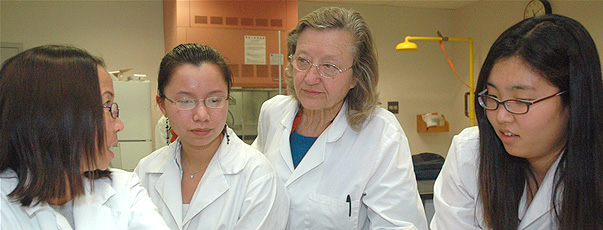Moving Heavy Metal
Professor's Research Focuses on How the Body Moves and Uses Copper
March 25, 2008
by Russ Hudson
Copper is needed by all living organisms for health, growth and survival. In the human body, copper is normally “sent” to the liver from where it is distributed via the bloodstream to various parts of the body as needed.
But not in lactating mothers.
Most of the copper in a lactating mother skips the liver and goes to the mammary glands and into the mother’s milk, where infants are the beneficiaries of the necessary nutrient.
How the metal is directed, and what it can do once it gets there, is the subject of decades of research by Maria Linder, chair and professor of chemistry and biochemistry.
This phenomenon and related copper transport issues are the basis of what Linder and her research students study. Currently, her focus is how copper gets from the blood into a mother's milk. Linder's research received $189,433 from the National Institutes of Health (NIH) this year — the fifth year in a five-year, $1.4 million NIH grant.
The NIH and the National Science Foundation have sponsored nearly half of Linder’s research, including recently conducted studies on iron absorption in the intestines, which is supported by a $640,000 NSF grant.
“There are important nutritional implications to this research,” said Linder. “Our research is expected to reveal a lot about the basic transport processes involved in supporting the metabolic roles of copper in the body.”
Linder’s goal is to determine the processes within a cell that allow copper transfer across membranes and through cell compartments to copper-binding proteins that then leave the cell and enter breast milk.
As part of her research, Linder has been working with colleagues and students from Deakin University in Australia.
The link between cancer and copper was the instigator of Linder's research focus.
“We know that in cancer patients the amount of copper in the bloodstream goes up. Cancer cells are hungry for copper, but certain copper compounds also inhibit cancer growth,” said Linder, who received her doctorate in biochemistry from Harvard University and conducted post-doctoral research at Harvard and MIT. “Understanding the normal roles and transport of copper will thus help us to understand this disease.”
Since she arrived at Cal State Fullerton in 1977, the professor has garnered millions of dollars in research grants — more than $3.5 million in the past decade alone — particularly so-called “Research 1” grants from the NIH. Usually awarded to institutions that emphasize research over teaching, such grants are more difficult to obtain within the California State University system, where teaching is the primary mission.
The veteran researcher has received many honors, including the American Chemical Society Award for Research at an Undergraduate Institution, the California State University system’s Wang Family Excellence Award in 2007 and Cal State Fullerton’s Outstanding Professor Award in 1984-85.
Linder's research on copper and iron biochemistry has been published in two books — “Biochemistry of Copper” coauthored with C.A. Goode in 1991 and published by Plenum and “Nutritional Biochemistry and Metabolism” published by Elsevier — as well as in more than 100 professional journals.


